 |
Home | Search | Browse | About IPO | Staff | Links |
 |
Home | Search | Browse | About IPO | Staff | Links |

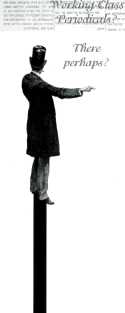
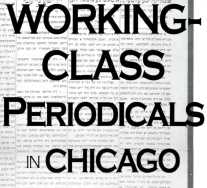
Jon Bekken Journalism history is typically told in terms of America's "great newspapers" and their makers, papers such as the Chicago Tribune, the Times, or the often-bloody circulation wars that raged in the years before World War I. But like other cities, Chicago's newspaper scene was much more complex, including thousands of monthly, weekly, and daily newspapers that have too often been overlooked by historians. The city was advantageously situated on railroad, shipping, and postal networks, and served as a publishing center for the entire country. The American Medical Association's journals, for example, were published from Chicago for national distribution, as were the city's two Lithuanian-language dailies, while the Daily Racing Form and National Hotel Reporter enjoyed at least regional circulation. Swedish-language papers published in Chicago circulated throughout the United States, printing local news from scattered Swedish communities. (Newspapers and magazines published in other cities also circulated freely within the city, on occasion outstripping the circulation of local papers.) The number of Chicago daily newspapers published doubled (to thirty-seven) between 1880 and 1900 and continued to gradually increase until reaching its peak in 1925 (forty-five dailies) and beginning a gradual decline. More than 125 daily newspapers were published between 1880 and 1930, but most were not the English-language general circulation dailies we typically think of when we imagine the daily newspaper (even if those papers tended to have larger circulations). Rather, the "typical" daily newspaper was either a foreign-language newspaper appealing to the city's (and the region's) growing immigrant populations, or one of several specialized papers serving audiences such as meatpackers, lawyers, partisans of various political organizations, horse-racing enthusiasts, or neighborhoods that desired their own communications media. Other urban centers in Illinois also supported a diverse press, while smaller towns were served by a mix of out-of-town papers, local weeklies, and foreign-language papers in areas where immigrants were concentrated. Chicago-and St. Louis-based newspapers circulated through much of the state, with early urban dailies publishing weekly editions intended for rural readers and later the Chicago Tribune and Evening Journal (among other papers) publishing daily editions timed to rail schedules for downstate distribution. While a proposal to establish a workers' newspaper was floated by William Manning in 1797, the first United States labor papers were launched in the 1820s, and the first foreign-language labor paper appeared in German in the 1840s. The working-class press peaked in the period of the 1880s through the 1920s, before being decimated by a combination of the Great Depression (which wiped out many of the mutual-aid associations that supported this press), laws that slashed the number of new immigrants, and post-war repression. Many of these publications related to their readers in ways quite different than the general-circulation press. Labor editors were, for the most part, drawn from the ranks of the movements they served, sharing their linguistic and ethnic diversity, social and economic circumstances, and aspirations. Their newspapers were an integral part of the working-class communities they served, not only reporting the news of the day or week, but offering a venue where readers could debate political, economic, and cultural issues. The working-class press stemmed from an alternative press ideology, one that sought to erase distinctions between newspapers and readers and to involve its supporters in every aspect of the newspaper, from management 24 and editorial decisions to reporting. By the 1890s most Illinois cities with a substantial industrial presence hosted labor newspapers, often oriented toward workers in skilled trades, such as the Bloomington Trades Review (launched in the 1890s) or the Tri-City Labor Review. The Progressive Mine Workers of America issued their Progressive Miner (1932-1957) from Marissa, while the competing United Mine Workers of America issued the Illinois Miner (1920-1933) from Springfield. Although labor papers were published throughout the state, the center of the working-class press was in Chicago, where unions and mutual-aid associations published a wide variety of papers ranging from foreign-language dailies to newsletters serving workers in a particular trade or union. Chicago was home to some of the country's best-known labor papers, such as the pioneering Workingman's Advocate (1864-1877), the Chicago Federation of Labor's The New Majority (1919-present, now Federation News), as well as the headquarters for the labor-news service, Federated Press (1919-1956). Several unions published their national papers from Chicago, including the American Train Dispatchers Association, the Building Service Employees' International Union, the Industrial Workers of the World, and the United Packinghouse, Food and Allied Workers. 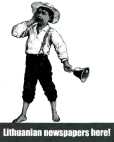
Chicago was a working-class city, an immigrant city, and a union city. Many of its residents could not read English with any facility. By 1900, three-fourths of Chicagoans were either immigrants or the children of immigrants, with substantial German, Polish, Swedish, Czech, Russian, and Irish immigrant communities. By 1930, as the city continued its rapid growth, the immigrant population was still slightly more than half of Chicago's population, with substantial new immigrant communities of Greeks, Hungarians, Italians, Lithuanians, and Yugoslavians. These immigrant communities provided the labor that fueled Chicago's garment, meatpacking, and steel industries, and made the city an industrial powerhouse. They were served by daily, weekly, and monthly publications in dozens of languages. As early as 1880, Chicago supported three competing German-language and Czech- and Norwegian-language dailies, out of a total of 11 daily newspapers published in the city. By 1920, foreign-language papers accounted for 24 of Chicago's 36 daily newspapers, issued in Czech, German, Italian, Lithuanian, Norwegian, Polish, Russian, Slovak, and Yiddish. 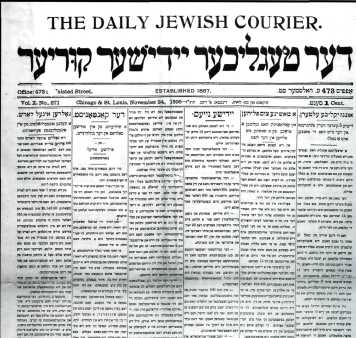 The Daily Jewish Courier, 25 By 1900 Chicago newspapers operated in several distinct, if sometimes overlapping, ecological niches. The Chicagoer Arbeiter-Zeitung (a German-language labor daily jointly owned by union locals, mutual-aid associations, and other working-class organizations) did not compete in any meaningful way with a paper such as the Chicago Tribune, which served a more upscale, English-speaking, Republican readership. General-circulation papers typically had lower cover prices and more pages than did their more specialized counterparts, reflecting the growing importance of advertising to newspaper economies. However, the number of specialized publications soared from the 1890s to 1925, even as the number of general-circulation papers steadily declined. 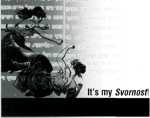
Much of the working-class press was not formally linked to national unions. In many cities, publishers (often union printers who had opened their own shops) issued weekly newspapers endorsed by local unions but run as private businesses. Mutual-aid societies and socialist parties published daily, weekly, and monthly newspapers to promulgate their message and to provide news and viewpoints often excluded from the general-circulation press. Chicago's immigrant working-class communities supported newspapers ranging from publications quite similar (language aside) to mainstream dailies such as the Chicago American or the Daily News to militant papers deeply enmeshed in the lives of the ethnic communities that published them. Many of these newspapers circulated throughout the Midwest, and often had correspondents throughout the region to report on local events. Most immigrant communities had a choice of newspapers. Czech readers, for example, could choose between four dailies: Svornost (the oldest), Denni Hlasatel (cooperatively owned by its typesetters, Hlasatel competed with Svornost to serve the free-thought community), Spravedlnost (owned by the Czech socialists and supported by local unions), and the Catholic Narod (owned by the Benedictine fathers, and a distant fourth in circulation). Each paper was linked to competing dense networks of community organizations tied to the Catholic church, to unions, or to Czech free-thought societies (ranging from mutual-aid societies to drama and singing groups). Originating in a strike against Svornost, Denni Hlasatel (the Daily Herald) proclaimed itself a labor daily but was primarily committed to the cause of ethnic solidarity. While ethnically based, Spravedlnost (Justice) identified with broader trans-ethnic working-class struggles, firmly supporting the Socialist Party and the Chicago Federation of Labor. Every significant immigrant community brought forth its own labor publications. Scandinavian (Norwegian, Danish, and Swedish) members of the Knights of Labor published the weekly Arbeider Journal (Workers' Journal) from 1887 through 1899, following in the footsteps of the earlier independent Wye Tid (New Age), which had ceased publication in 1884 after seven years. (An independent socialist paper of the same name was issued in Chicago from 1910 to 1915; the Communist Ny Tid was issued in the 1920s and 1930s.) Some publishers issued radical papers as commercial ventures, such as Christian Botker's Danish-language weekly Revyen (The Review), published from 1894 to 1921 and loosely aligned with the Socialist Party. The leading Swedish-language socialist paper, Svenska Socialisten, was issued from 1905 to 1911 in Rockford, and then from Chicago until 1922. While most working-class publications focused on labor, politics, and general news, many also included articles on science and other educational material as well as extensive cultural sections. Radicals also published humor or satirical journals, including the Swedish-language Amerika-Narren (America Fool) and the Polish Bicz Bozy (God's Whip, whose bitter lampoons of the clergy resulted in criminal charges against the editors); and working-class literary journals such as the Swedish-language Bokstugan (Book Cabin), issued from 1919 to 1926 by the Verdandi Study League, loosely linked to the Industrial Workers of the World. The foreign-language press was often the scene of fierce conflict. Chicago's Yiddish-language press reflected this conflict in the long-running battle between the Courier (which stressed ethnic solidarity) and the Yiddishe Arbeiter Welt (Labor World), succeeded by the Chicago edition of Vorwaerts (Forward, a socialist daily that successfully fused class and ethnic consciousness, and quickly came to dominate readership in Chicago's predominantly working-class Jewish neighborhoods). Chicago's immigrant Jewish community was initially served by the daily Jewish Courier, which stressed ethnic solidarity but generally supported labor struggles by Jewish workers. These early immigrants, largely Hebrew readers from German territories, were displaced by later waves of East European Yiddish-speaking immigrants who brought very different cultural, political, and religious traditions with them. The Yiddish-language working-class press became firmly established in 1908 with the launch of the weekly Arbeiter Welt. The Arbeiter Welt was supported by an extensive network of clubs and societies, running the gamut from cultural and fraternal associations to women's clubs and political organizations. Like other immigrant papers, the Arbeiter Welt actively participated in its community. When Chicago garment workers (many of them Jewish) struck in 1910, the Arbeiter Welt collected nearly $20,000 in strike-relief funds, and briefly converted to daily publication to promote 26
the strikers' cause. Arbeiter Welt editors spoke at union and socialist meetings, served as union organizers, and made their paper's columns available to the strikers. The paper resumed daily publication in 1917, became the Chicago edition of Vorwaerts (Forward) in 1919, and continued daily publication until 1951 (when the Chicago edition was incorporated into the New York City paper). While many of the news columns and features in this later period were written in New York, the Chicago edition carried extensive local material and maintained editorial and printing facilities in the city. Similarly, by 1920, Polish-speaking workers could choose between five daily newspapers, including the Socialist Dziennik Ludowy and the Polish National Alliance's Zgoda (published to this day). Like the Zgoda, most of these papers were owned by community organizations—mutual-aid societies, union locals, singing societies and the like-which relied on them to provide news of their activities and to knit together readers dispersed in different neighborhoods. These community networks came together behind very different notions of ethnic identity. For the Polish Roman Catholic Union, Polishness revolved around religion; for the Polish National Alliance, it revolved around a commitment to an independent Poland. When a worker subscribed to Dziennik Zjednoczenia, he reaffirmed a commitment to the Catholic church and its leading role; a subscription to Dziennik Ludowy entailed a very different but equally significant commitment to a workers' movement that transcended ethnicity. Many immigrant communities supported competing newspapers. Lithuanian readers could choose between the social-democratic Naujienos (News), the Catholic Draugas (Friend), or, from the 1920s, the Communist Vilnis (Struggle). Readers were actively encouraged to write for the news columns of these papers, and indeed their accounts of meetings, working conditions, and local struggles made up a large share of the papers' content. Many were owned by community organizations that directly, or indirectly through publishing cooperatives, controlled the papers' policy and elected their editors. There were heated debates in many union locals and other societies over the policies their newspapers should follow and in regular assemblies where editors reported to their communities. If funds ran short, as they often did, community organizations would organize benefit concerts, picnics, and festivals to meet the need. Vilnis readers even turned weddings or birthday parties into fund-raising opportunities: in February 1926 a collection at one birthday party raised $36 to help the paper go daily. 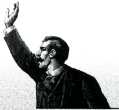 
27 Readers wrote for their newspapers, elected their editors, and donated funds to cover their deficits. Editors spoke at union rallies, opened their papers' columns to announcements from community organizations, and mobilized readers behind labor campaigns. When police arrested the entire editorial staff of the daily Chicagoer Arbeiter-Zeitung in 1886 in the aftermath of the Haymarket explosion, blacklisted McCormick Reaper worker Gus Belz and other readers stepped forward to take their places. When Belz died (at age 31) two years later of tuberculosis, his obituary noted that he had worked such long hours at the paper that he practically lived in its offices for several months. Such a close relationship between readers and newspapers was more typical of immigrant papers than of their English-language counterparts. The Chicago Daily Socialist (1906-1912) boasted that every reader was also a reporter, and established institutional mechanisms to ensure accountability. But while all working-class papers published articles written by union officials and other community members, in practice the English-language labor press tended to rely more heavily on paid staff to produce newspapers that straddled the divide between emulating the mainstream press and following a more community-oriented model that blurred the distinction between readers and communicators. Immigrant workers faced a choice between contrasting ideologies and institutional networks based upon class and ethnicity, each of which lent itself to different alliances and strategies. American-born workers faced similar choices-between nativism and internationalism, self-improvement, and class struggle. Workers developed a sense of who they were and of what sort of society they lived in in the interplay between these visions. These issues were particularly vital for foreign-language editors and for the communities they served. Certainly the decision to subscribe to a newspaper or to join a mutual-aid society was often made for reasons that went beyond such concerns. Newspaper price, breadth and quality of coverage, and the influence of friends and co-workers all figured in the mix. But joining a mutual-aid society, attending an ethnic hall, or reading a newspaper was not merely a reaffirmation of ethnic identity; it raised broader issues of class, of religion, and of one's place in American society. Chicago's working-class press thus not only served otherwise unmet informational needs; these newspapers served as examples of a more democratic media practice that provided working-class communities with forums in which they could debate the pressing issues facing their communities, shape a common response, and mobilize their participation in the broader society. They were building blocks in a public sphere that perhaps no longer exists, a political process that implicitly recognized a multiplicity of interests, and provided spaces in which they could come together—simultaneously preserving their distinct identities and taking their place in the broader polity.  Howard J. Romanek The examination of the working-class periodicals in Illinois provides students with the opportunity to grapple with some important questions. What is the purpose of a newspaper? What were the different visions of the role of the newspaper in an increasingly urbanized America? What is the relationship between a newspaper and its reader? What does the act of reading a newspaper have to do with one's own identity? How is it decided as to what gets covered in history books? What problems confront the historian? 28 This material is appropriate for United States history and urban studies classes. These activities may be appropriate for Illinois Learning Standards 14.D.4;16.A.5a; 16A5b; 18.A.4; 18.B.4; 18.C.5. Teaching LevelGrades 10-12 Materials for Each Student • Understand different roles of newspapers • Describe similarities and differences between mainstream and non-mainstream newspapers • Analyze the differences among foreign-language newspapers published in immigrant communities • Understand the relationship between a newspaper and its reader • Understand the problems that confront the historian 
The student should be assigned the article's narrative portion several days before any of these activities are done in class. Handouts 2-4 are designed for a single class period. Handout 1 may need two class sessions. Follow-up assignments are possible for each handout. The student should receive Handout 1 when the narrative is assigned to be read outside of class. The student will complete part one of Handout 1 outside of class. The instructor and the class will do part two of Handout 1 together. For Handouts 2, 3, 4, and 5, the instructor will give the student the handout at the beginning of the class session. These handouts should be done after the instructor and the students have completed Handout 1. The questions may be discussed with the whole class. The instructor may divide the class into groups for discussion and, then, later call upon the groups for their answers. The instructor may also designate a person from each group to write down some of the specific comments made by its members. The answers would be collected at the end of the class. If the class has been divided into groups, the instructor should move from group to group to monitor and answer questions. At the end of the class session using Handout 1, 2, 3, 4 or 5, the instructor can ask the student to write down the most important idea learned in class today. This should be given to the teacher as the student leaves the class. The teacher may want to use these comments as a learning activity at the beginning of the next class session. Students could research the following topics: • The early foreign-language newspapers in the United States • Foreign-language newspapers and radio and television stations in Illinois • The history of one of the immigrant communities mentioned in the narrative portion of the article The instructor may assign an essay based on the article and handout(s). Another possible assessment is having the class do some research. The instructor would then assign one-half the class to create an issue of a general circulation newspaper from the period discussed in the article's narrative portion. The other half of the class could create an issue of a working-class newspaper. 29
 It is important to learn how to analyze a reading. Before the class session, you will (1) read the narrative portion of this article and (2) complete the definition article in part 1. Together with your teacher, you will analyze the narrative in class. Part One (Words to Know) It may be hard to analyze a reading if you do not know the meaning of unfamiliar words. Please write a definition for each of the following words that may not be known to you. 1. partisan (n.) 2. linguistic (adj.) 3. diversity (n.) 4. decimate (v. t.) 5. ideology (n.) 6. venue (n.) 7. niche (n.) 8. promulgate (v. t.) 9. enmesh (v. t.) 10. satire (n.) 11. emulate (v. t.) 12. nativism (n.) 13. internationalism (n.) 14. interplay (n.) 15. reaffirmation (n.) 16. multiplicity (n.) 17. polity (n.) 30  Part Two (Analysis of the Narrative) When analyzing a reading, why is it important to know the background of the author? What is the background of the author of the narrative section of this article? What qualifies him to write this narrative? Why did the narrative author of this section write it? What is the thesis of the narrative author of this section? What was the major point the author was attempting to convey in the narrative? Did the narrative author just assert his thesis or did he give specific facts to support it? Explain. Give some examples of statements of fact in the narrative. Give some examples of statements of opinion in this narrative. What are your reactions to the narrative? Do you agree or disagree with the thesis in the narrative? Was the narrative well written and organized? Did the narrative's author acknowledge other viewpoints? In no more than four sentences, give a summary of the narrative portion of this article. (Looking at your summary, would it be helpful to someone who has not read the narrative, or would that person believe your summary is too vague?) 31  Some historians believe that Julius Caesar is responsible for the creation of the first newspaper, about 59 B. C. The news was written on large white boards. Newspapers could be found in China in the eighth century. About 1450, Johann Gutenberg developed a new kind of printing based on moveable type. This led to the rise of the modern newspaper. By the beginning of the eighteenth century, newspapers were being published in western European cities, and by 1783, there were over forty newspapers printed in the United States. By the end of the eighteenth century, foreign-language newspapers had already appeared in the United States. The number of newspapers grew tremendously in the United States, especially after the Civil War, but during the twentieth century, the number of published newspapers declined. Questions 1. What is the purpose of a newspaper? 2. How did people exchange news before newspapers appeared? Besides newspapers, how do people exchange news in the twenty-first century? 3. In his book The 100: A Ranking of the Most Influential Persons in History (New York: Hart Publishing Company, 1978), Michael Hart declared that Ts'ai Lun (he lived about A. D. 105), the inventor of paper, was the seventh most influential person in history. Ranked eighth was Johann Guttenberg. How did the inventions of Ts'ai Lun and Johann Gutenberg change the course of history? 4. In the 1850s, giant presses were able to print 10,000 newspapers every hour. By 1900, a press run by electricity could produce 150,000 copies of a twelve-page newspaper in one hour. What is the significance of this? 32  5. Every new invention or innovation can affect people and institutions. It also can present new opportunities, challenges, and institutions. It can produce winners and losers. (How many people are employed making manual typewriters today?) Some people and institutions welcome change; others are threatened by it. How did the following inventions affect the newspaper industry? telegraph camera radio television Internet 6. The author of the narrative section of this article stated that "the number of specialized publications ... climbed steadily from the 1890s to 1925, even as the number of general-circulation papers was in an inexorable decline." What might account for the decline? 7. Every time a daily or weekly newspaper ceases publication, how might its "death" affect the population it once served? 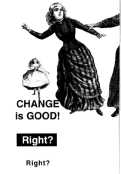
33 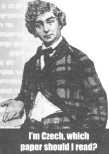
The author of the narrative section of the article states that "many immigrant communities had a choice of newspapers," and that "immigrant workers faced a choice between contrasting ideologies and institutional networks...." Questions 1. Below are listed some of the immigrant communities covered in the narrative section of the article. Looking at the specific foreign-language newspapers published in that community, in what ways might the community be divided? Czech community Polish community Lithuanian community 2. From reading the narrative section of this article, what specific questions did an immigrant have to ask and answer before choosing the newspaper that would be read daily? What does reading a specific newspaper have to do with one's identity? Does everyone in your class read the same newspaper and magazine? If not, what might account for this? 34  3, The author of the narrative section of the article writes that immigrants struggled with the problem of identity. What about you? A person comes up to you and says, "Who are you? Identify yourself." What makes up your identity? Would you tell that person that you are a member of a specific religion? Is your religion part of your identity? Make a list of how you wish to be identified. Looking at your list, which one is most important to you? What would you first tell the person who asked you about your identity? Do you believe that your classmates would you give the same answer you did? What is the significance if your classmates can agree on which one is the most important? What is the significance if your classmates cannot agree on which one is most important? 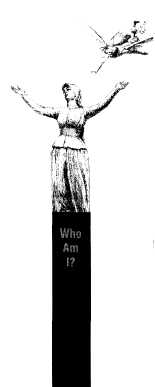
35  
Questions 1. After reading the narrative section of the article, how were the working-class and foreign-language newspapers similar to mainstream or general-circulation newspapers such as the Chicago Tribune? How were they different? 2. Looking at your school newspaper, how is it similar to mainstream or general-circulation newspapers? How is it similar to the non-mainstream papers described in the narrative section of the article? 36  The author of the narrative section of the article states in his opening paragraph that historians writing about the history of journalism in the United States have overlooked many monthly, weekly, and daily newspapers that existed in earlier times. Let's do some pretending. The year is 6006. Although the people of this period are certainly aware that there have been many civilizations that preceded theirs such as Western Civilization, which ended around 2250 A.D., they wish they had more knowledge of these civilizations. You are a historian, and you have just received the only written materials from a recent archaeological dig from an area that was called Chicago. It has been determined that these writings are over 4,000 years old. After reading these materials, you will write a report— "Life In Chicago." Your report will be distributed so that people will have a better understanding of ancient people. If you were examining issues of the Chicago Tribune, what would people in 6006 be learning about Chicago? Would you be capable of giving an accurate picture of Chicago? If you were examining issues of the Arbeiter-Welt, what would people be learning about Chicago? Would you be able to give an accurate picture of Chicago? Let's return to the twenty-first century. You have probably read history books and articles for your classes. Are they more accurate than what a historian from the future could write about Chicago? What problems confront the historian? Why do some things get covered by historians, and why do other things get overlooked? Can all of history be covered by historians? Who decides what should be covered? Is it more important for students to learn about the history of the Chicago Tribune than a foreign-language newspaper such as the Vorwaerts? 37 |
|
|